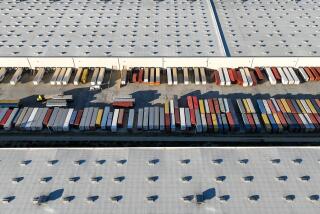Reviving Urban ‘Brownfields’
Forty-three banks turned down developer Jeff Lee before he landed a loan to transform the polluted site of a former United Parcel Service depot into the first million-dollar condos in downtown Los Angeles.
“We took a huge risk,” said the president of Marina del Rey-based Lee Group. “It was hard to convince the financial community that it would work.”
Lee, who has since sold all but one unit at his upscale Flower Street Lofts near Staples Center, sees a profitable future in turning old factories, long-abandoned warehouses and other less-than-pristine real estate into badly needed urban housing.
But redeveloping such areas, known as “brownfields,” is rife with pitfalls.
Even though these projects aren’t as prohibitive as taking on a federal Superfund site, which can cost hundreds of millions of dollars to treat, cleaning up the toxic soil and water at a brownfield is still costly. Dealing with state environmental regulators is complicated, as well. And obtaining insurance is daunting.
So, Lee and other developers are looking for help from Sacramento, where state Sen. Gil Cedillo (D-Los Angeles) has sparked the hottest environmental debate of the year with a bill that would make it easier to build on some of California’s estimated 100,000 contaminated industrial and commercial properties.
“We need a stronger incentive program to take back the urban areas in a manner that will be clean, vital and productive for all,” said Cedillo, who remembers playing in abandoned factory buildings while growing up during the 1960s in Boyle Heights.
Over the years, Southern California developers have turned a number of contaminated brownfields into profitable assets. An old commercial laundry in Santa Monica is now a high-end condominium complex. A former Kaiser steel mill in Fontana became a NASCAR speedway. New houses sprouted in Commerce next to a closed landfill.
More modest sites, such as shuttered gas stations with leaking underground tanks, have been reborn as retail shops.
Most of the brownfields are located in heavily developed, rundown neighborhoods or in more sparsely populated, heavily industrialized areas. Almost all of them are polluted to some degree, raising the potential for expensive cleanup bills.
Before building its Bay City Lofts in Santa Monica, the Lee Group had to haul away soil tainted with lead and other toxic metals released by leaking underground fuel tanks. The company monitored the groundwater under the site for contamination for more than a year.
To develop 102 units of affordable housing in the Bell Gardens-Commerce area, the Lee Group installed an extraction system to remove methane from a former dump underneath nearby Veterans Park.
Despite these headaches, brownfields are becoming an attractive investment as land values soar, open space becomes ever harder to find and developers look for inner-city properties that can be converted into housing.
“There is a vast, underutilized economic potential for these sites,” said Stuart A. Gabriel, executive director of the Lusk Center for Real Estate at USC.
Indeed, despite the Flower Street project’s high front-end costs -- the property was priced at $5.7 million, environmental mitigation work totaled $600,000 and refurbishing the old UPS depot cost $37 million -- Lee said “we did very well. We would do it again.”
Though no firm numbers are available, experts suggest that so-called urban infill redevelopment, including many brownfield sites, generates about 6,500 new housing units annually in Los Angeles -- about half the city’s housing needs.
Lee and other developers maintain that they could be doing a lot more if Cedillo’s bill, SB 493, becomes law.
As proposed by Cedillo, the measure would encourage the development of brownfields by spelling out the obligations of developers to clean up soil pollution caused by previous owners. However, the bill would limit the future legal liability of developers to treat tainted underground water as long as that water is not used for drinking and does not pose a threat to human health or safety.
Developers say they want assurances that they won’t be hit by lawsuits or cleanup orders once regulators give the go-ahead to start construction. Such protections, Lee explained, would make it easier to obtain financing, insurance and public redevelopment funds to build on more brownfields.
Environmentalists agree on the need to slow urban sprawl and revitalize inner cities by recycling abandoned properties. But they draw the line at changing the state law that holds owners responsible for cleaning up polluted groundwater beneath their property.
The Cedillo bill doesn’t address “the fundamental issue of who is going to clean up the groundwater,” said Jane Williams, director of California Communities Against Toxics.
What’s more, the bill could set a bad precedent by granting “broad immunities” to state water-quality laws, said Assemblyman John Laird (D-Santa Cruz), chairman of the key Assembly Environmental Safety and Toxic Materials Committee.
For now, the environmentalists have the upper hand.
Cedillo’s bill passed the Senate 37 to 0, but was gutted in Laird’s Assembly committee when environmentalists refused to give way on the groundwater exemption. They also insisted that state agencies should be able to order additional cleanup, even after telling a developer that “no further action” is needed.
Cedillo remains optimistic that the essential elements of his bill can be restored in late August, during the hectic, final days of the legislative session. And he’s counting on strong support from Gov. Arnold Schwarzenegger.
The senator has an important ally in Terry Tamminen, head of the California Environmental Protection Agency and former director of the conservation group Santa Monica BayKeeper. Tamminen, who has an impeccable reputation among environmentalists, said he was committed to getting a bill passed this year that would make it economically viable to build on brownfields, without sacrificing environmental quality.
“These sites need to be put back into productive use,” he said.
Although he concedes that ground water pollution is a serious problem, Tamminen doesn’t believe its fair to punish builders for the environmental sins of their predecessors.
Cedillo also expects his colleagues in the Latino Caucus -- including Assembly Speaker Fabian Nunez (D-Los Angeles) -- to side with him in what is shaping up as an intramural spat between inner-city, minority lawmakers and more environmentally inclined coastal Democrats.
Usually allies, the two groups of legislators differ over how to balance the environmental and economic needs of the state’s city dwellers. Cedillo contends that reducing blight, creating jobs and generating tax revenues is more important than eliminating all traces of contamination in groundwater.
“We don’t have the luxury of being purists,” he said.
More to Read
Sign up for Essential California
The most important California stories and recommendations in your inbox every morning.
You may occasionally receive promotional content from the Los Angeles Times.











